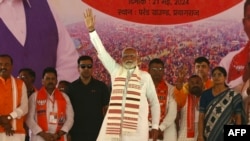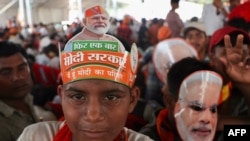From deep fake videos created by artificial intelligence to social media influencers who hold sway with young people, political parties in India are using all the tools of the digital age to expand their outreach to voters as the country holds its mammoth general election.
AI-generated images, audio and videos have helped politicians connect directly with tens of thousands of voters. Stalwart political leaders who have died have been resurrected to cash in on their popularity. Deepfake videos of Bollywood stars criticizing Prime Minister Narendra Modi have gone viral before being taken down.
“It’s the first time that AI has been disseminated on such a large scale,” said Divyendra Singh Jadoun, who calls himself the Indian Deepfaker and has had a packed schedule in recent months, creating synthetic content for political parties.
In a country where more than 800 million people are on the internet, how will it impact democracy?
“Are these uses significant enough to actually change someone’s vote? That is still an unanswered question,” says Prateek Waghre, executive director of the Internet Freedom Foundation, a digital rights group based in New Delhi. “In the Indian context, you already have political parties relying heavily on pushing certain narratives, misleading messages, etc. Over and above that, how much difference is synthetic content making is a question mark.”
In a country where each parliamentary constituency has about two million voters, Jadoun and his team have created AI avatars that address voters by name to deliver personalized messages to seek their support. Then there are AI-powered chatbots that call constituents in the voices of political leaders.
Plummeting costs have made it possible to do it on a mass scale. “Four years ago, it used to take us several days to create a one-minute AI video. Now anybody, even if they don’t have knowledge of coding, can take one single image of a person and an audio track to create one,” said Jadoun.
During the election campaign in the southern state of Tamil Nadu where voting has now concluded, Muthuvel Karunanidhi, a tall leader of the Dravida Munnetra Kazhagam regional party who died in 2018, was seen in videos wearing his trademark dark glasses praising the leadership of his son, M.K. Stalin, the state’s current chief minister. The idea was to enthuse the party cadres.
Disinformation remains the biggest challenge. Days after India’s phased election got underway last month, two videos that went viral showed Bollywood stars Ranveer Singh and Aamir Khan criticizing the government and seeking votes for the opposition Congress Party. Both were deepfakes.
Another video alleging that opposition Congress Party leader Rahul Gandhi had resigned from the party took social media by storm last month — his AI-generated cloned voice was used to support the claim.
Jadoun said that among the enquiries he receives but turns down are requests to create deep fake videos of political opponents to tarnish their reputations. “A common way is to swap the face of the opponent leader and paste it on to a controversial comment he never made. The second is to clone his voice and make him say something he has never said to discredit him,” he said.
India’s Election Commission has warned political parties against using AI to spread misinformation, but there is little regulation in place.
“You can only create awareness among people,” said Jadoun. “If a video is escalating their emotions, they should pause before sharing it.”
He says he labels his videos “A.I. generated,” and chatbots announce that they are A.I.-generated voices.
AI is also being put to softer uses. In Tamil Nadu, where Modi’s ruling Bharatiya Janata Party (BJP) is trying to establish its footprint in a state far away from the Hindi heartland that the Hindu nationalists dominate, AI generated versions of Modi singing popular Tamil songs helped expand his reach, according to Muralikrishnan Chinnadurai, a fact-checker based in the state.
“These were widely shared. It made people see him as a more approachable, softer leader. While it may not influence older, more politically savvy people, such content has the power to impact young voters,” he said.
AI is not the only new factor in India’s election. In the country with the world’s largest number of people on both YouTube and Instagram, political parties have also mobilized influencers in a campaign to woo voters.
The BJP, a party that was always savvy in its use of social media, is seen as being ahead of others. In March, just about five weeks before the election got underway, Modi handed out awards to 24 prominent social media influencers at the country’s first-ever National Creators Award ceremony to promote "storytellers of a confident, assertive New India."
Critics saw it as an effort to coopt them in the election campaign and create an incentive for them to endorse the government.
State units of the BJP have been holding influencer meetings to persuade them to spread the message about the work the government has done. In the past year, prominent politicians and ministers have sat down with influencers for interviews.
“It’s a fuzzy and pretty concerning development. The challenge is that these interactions are very different from what you would expect with a journalist,” said Waghre. “It is going to be a very soft conversation where the politician is unlikely to be challenged on claims they make and then that message is being carried to the influencer’s audience exactly as the politician wants it to go.”
He says this tactic is going to be hard to regulate and over time one could result in less reliance on traditional media.















